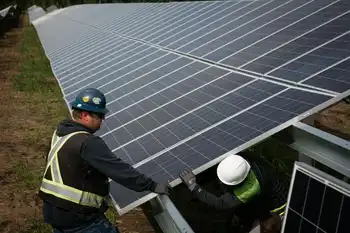Neighbourhood fights underground transformers
By Toronto Star
Protective Relay Training - Basic
Our customized live online or in‑person group training can be delivered to your staff at your location.

- Live Online
- 12 hours Instructor-led
- Group Training Available
“There’s a lot of fear in the room,” Brandy said as 50 of her neighbours nodded assent.
The project: Burying hydro lines and transformers on several streets around White Birch Rd. in the Warden Ave.-Kingston Rd. area.
The objection: Many houses with tiny front yards will end up with a transformer buried beneath, topped by a shiny galvanized steel grill and plate measuring 1.24 metres by 2.28 metres — about four by seven feet.
The plate covers a concrete vault containing the transformer, its bottom 1.96 metres deep.
And many residents wonder about the health impact of a transformer with its electro-magnetic field sitting that close to their houses.
“I don’t have enough information about the technology that’s being installed,” said Brandy. “And I don’t have any trust that what I’m going to be told is honest and truthful.”
She wasnÂ’t alone.
“It’s going to be three metres from our living room,” said Pierre-Yves Pouliot just before the meeting started.
“Not only will it be an eyesore. We think putting a transformer with 5,000 volts close to our living room window isn’t the safest thing.”
Toronto Hydro says that putting hydro underground is part of modernizing its system.
It has 12,000 customers sprinkled across the city with the same kind of service as White Birch who are also slated for underground service.
Wires in the White Birch neighbourhood radiate from central backyard poles. Both the poles and wires are aging. As trees grow, and as residents build decks and pools in their backyards, it gets harder and harder for hydro crews to get to poles, wires and transformers when trouble hits.
The area is plagued with power failures, hydro officials told the meeting — 160 in the past two years a figure that had residents shaking their heads in disbelief.
Failures in the area also cut power to thousands of other customers farther along the lines, Toronto Hydro says. The new system will be less failure-prone, and will allow the utility to re-route power and restore service faster if a failure does happen.
But residents complain that they were never properly notified.
Hydro told then the cables and transformer vaults would be buried. To them, that meant underground and invisible.
Instead, every 10th or 12th house has a transformer capped by a galvanized steel plate on the middle of their “postage-stamp” lawns, they say. Others have smaller “tap boxes” with plastic covers.
And many residents are unsettled by the proximity of the transformer vaults and their electro-magnetic fields, or EMFs, to their houses.
Moya Beall went to the website of Toronto Public Health, which advises residents to avoid the energy fields associated with any electrical equipment.
“You can arrange furniture and activity areas so that you do not spend a lot of time where EMFs are highest,” says the website. “Places where EMFs are usually the highest include: The electrical distribution lines the main circuit box major energy consuming appliances such as fridge, stoves, TV, computers.”
That raised a red flag for Beall.
“In our living room, our bodies are going to be closer to the tap box than to our refrigerator or circuit breaker,” she said. Toronto Hydro’s Jennifer Reynolds assured the meeting that all the installations follow federal guidelines for EMFs, and any exposures are “well below the guidelines” both inside and outside.
Residents like Patricia Rhodes, a realtor whose home is slated for a transformer, say property values will suffer, as prospective buyers look at the plate in the front lawn and say: “What the hell is that?”
Residents said they want a moratorium on the project. And they want compensation for those who may suffer reduced property values.
Councillor Gary Crawford, who organized the meeting, said Toronto HydroÂ’s communication with residents was unsatisfactory. But he couldnÂ’t persuade his colleagues on Scarborough community council to ask for a delay in the project.
Nor is Toronto Hydro willing to halt, Reynolds told the meeting.
“At this point in time, we do have to move forward,” she said.











